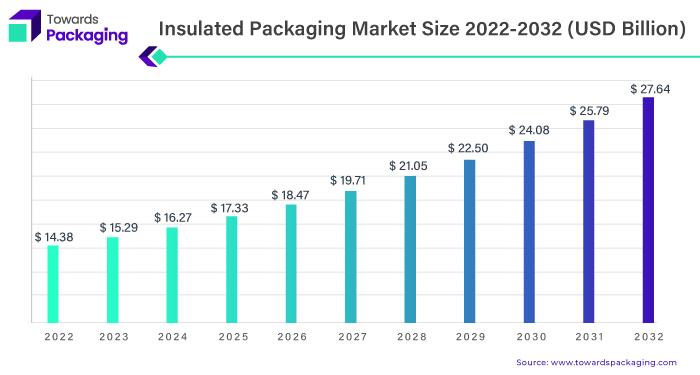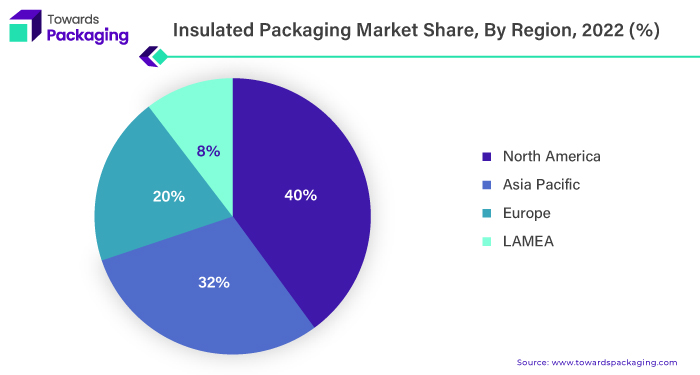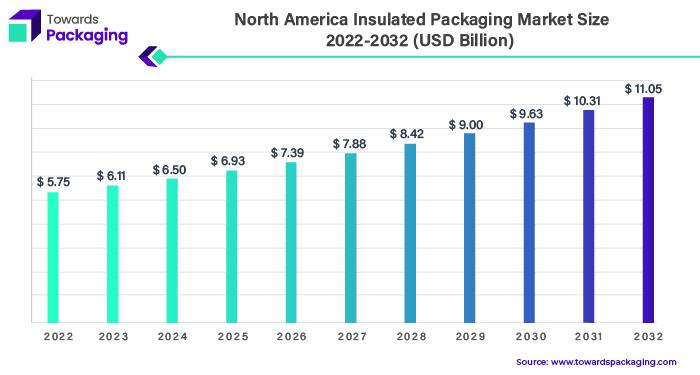The global insulated packaging market size is poised for remarkable growth, estimated to surge from USD 14.38 billion in 2022 to an anticipated USD 27.64 billion by 2032. This article explores the factors driving this expansion, technological innovations, regional dynamics, and the evolving landscape of consumer preferences.
Market Size and Projection
As of 2022, the insulated packaging market is valued at USD 14.38 billion, with a projected value of USD 27.64 billion by 2032, boasting a substantial 6.8% Compound Annual Growth Rate (CAGR). This analysis provides insights into the present and future state of the market, unraveling the key elements propelling its growth.

Changing consumer purchasing patterns driven by increasing health and wellness awareness are compelling, significant brands in the food & beverages, pharmaceuticals, and related industries to closely monitor rapid technological advancements and innovations in the packaging sector. End-user companies, especially those in the food & beverages and pharmaceutical sectors, are growing in preference for sustainable, eco-friendly, and health-focused packaging solutions. This enables them to uphold product quality, extend shelf life, and appeal to health-conscious consumers.
Additionally, the development of innovative insulated packaging market products made from recycled and recyclable materials, such as jute, is expected to boost the adoption of these eco-friendly packaging solutions in the future. These significant factors are anticipated to fuel the growth of the global insulated packaging market.
Key Takeaways
- Insulated packaging market plays a crucial role in the pharmaceutical industry.
- The global insulated packaging market grows due to regional factors; North America thrives with increased demand for temperature-sensitive goods.
- Corrugated cardboard, versatile and eco-friendly, plays a key role in the insulated packaging market.
Regional Dynamics of the Insulated Packaging Market: A Comprehensive Analysis

The insulated packaging market is experiencing significant global growth driven by various regional factors reshaping the industry landscape. North America’s market is thriving due to the increasing demand for temperature-sensitive goods, such as pharmaceuticals and perishable food items.

Government initiatives in Mexico are fueling substantial growth in the regional industrial sectors. The deliberate push for industrialization has created a conducive environment, attracting investments due to favorable conditions and a readily available workforce. These factors are instrumental in driving the region’s industrial growth. Furthermore, the established smart packaging sector and the government’s efforts to offer technologically advanced packing solutions are anticipated to boost the market significantly in the foreseeable future.
Financial support from esteemed organizations like the Organization for Economic Co-operation and Development (OECD) for manufacturing activities, combined with the rising demand for smart packaging products, particularly in the food and beverages sector, is expected to further propel the intelligent packaging market in the region. This trend is indicative of a positive trajectory for the market.
The growth of the IP industry in the region is also being bolstered by rapid urbanization, robust government financial standings leading to increased infrastructure investments, and a rise in disposable income among consumers. Government entities have engaged in strategic Public-Private Partnerships (PPPs) to foster the development of the electronics and automobile sectors. These collaborative efforts, driven by the governments, aim to deliver efficient, modern electronics, further stimulating growth in the Intelligent packaging industry. Businesses in this sector are positioned to benefit from these evolving market dynamics, offering ample opportunities for expansion and innovation.
Asia-Pacific is emerging as a key player in the global insulated packaging market, primarily due to the rapid growth of the e-commerce sector in countries like China and India. The rising middle-class population and changing consumer preferences have led to a surge in online shopping, fueling the demand for insulated packaging market solutions. In addition, the pharmaceutical industry in Asia-Pacific is expanding, with several countries becoming significant hubs for pharmaceutical manufacturing. This growth has created a need for insulated packaging market to transport temperature-sensitive drugs and vaccines safely.
India’s burgeoning population and rapid urbanization create a sustained demand for infrastructural development. Recognizing this need, the government has prioritized infrastructural growth to enhance trade competitiveness and manage the challenges posed by the country’s exponential population growth. Key initiatives such as the implementation of Goods and Service Tax (GST) for simplified taxation and the “Make in India” campaign promoting domestic manufacturing activities are pivotal drivers propelling the intelligent packaging market in India.
India is witnessing the establishment of numerous Special Economic Zones (SEZs) to cater to the rising demand for commercial office spaces, mainly by multinational companies and IT hubs. Additionally, the country’s population, income levels, and organized retail sector have experienced significant growth. Young consumers are inclined toward premium consumer goods, driving demand for higher living standards. This confluence of factors is expected to influence the IP market in India positively throughout the forecast period.
Businesses in the intelligent packaging sector are poised to benefit from these favorable conditions. The growing emphasis on infrastructural development and government initiatives aimed at simplifying taxation and promoting domestic manufacturing creates a conducive environment for the industry’s expansion. Moreover, the evolving consumer preferences and the increasing demand for premium products provide lucrative opportunities for innovation and market growth within the IP sector in India.
Corrugated Cardboard Drives Growth in Insulated Packaging Market Segments
The demand for efficient and sustainable packaging solutions has become paramount in the ever-expanding global market. Insulated packaging market stands out as a crucial segment, ensuring the safe transportation and storage of temperature-sensitive products. In this context, corrugated cardboard has emerged as a versatile and eco-friendly material, playing a pivotal role in the insulated packaging market.
Corrugated cardboard, composed of multiple layers of paperboard, is renowned for its strength, durability, and cost-effectiveness. This material is an excellent insulator, providing a protective barrier against temperature fluctuations. Its inherent insulation properties make it ideal for creating insulated packaging market solutions, especially for perishable goods such as pharmaceuticals, food, and beverages. The ability of corrugated cardboard to maintain the desired temperature within the packaging, shielding products from external heat or cold, is instrumental in preserving their quality and extending shelf life.
One of the primary drivers of the insulated packaging market is the growing emphasis on sustainability and environmental consciousness. Corrugated cardboard, biodegradable and recyclable, aligns perfectly with these eco-friendly trends. Businesses and consumers alike are increasingly seeking packaging solutions that minimize environmental impact. The use of corrugated cardboard in insulated packaging market addresses this demand, allowing companies to adopt greener practices while ensuring the safety of their products. Furthermore, corrugated cardboard is lightweight, reducing transportation costs and carbon emissions, thus making it an environmentally friendly logistics choice.
With its environmental benefits, corrugated cardboard offers versatility in design and customization. Manufacturers can engineer corrugated structures tailored to specific insulation requirements. These customizations include varying the number of layers, incorporating additional insulating materials, or creating multi-layered barriers. Such flexibility ensures that insulated packaging market solutions are effective and adaptable to diverse products and transportation needs. The ease of printing and branding on corrugated surfaces further enhances its appeal, allowing businesses to reinforce their brand identity and communicate vital information to consumers.
The insulated packaging market, bolstered by corrugated cardboard, is witnessing notable growth in various sectors.
Key Drivers of Market Growth
The increasing demand for temperature-sensitive products acts as a primary driver behind the growth of the insulated packaging market. The advantages offered by insulated packaging in maintaining product integrity throughout the supply chain, combined with the impact of e-commerce and online grocery trends, contribute to the sector’s upward trajectory.
Technological Innovations
This section explores the evolution of insulated packaging technologies, shedding light on innovations that enhance thermal insulation. From advanced materials to sustainable practices, the article delves into how technological advancements are shaping the landscape of insulated packaging.
Regional Analysis
Examining market trends across different regions unveils the diversity in consumer behavior and preferences. Cultural nuances, economic factors, and regulatory landscapes contribute to variations in the demand for insulated packaging, necessitating tailored strategies for businesses.
Industry Challenges
Despite the positive growth outlook, the insulated packaging industry faces challenges such as regulatory considerations, sustainable materials, and recycling challenges, and a competitive landscape. Addressing these challenges is crucial for ensuring the sustainable growth of the industry.
Market Segmentation
Understanding the diverse types of products under insulated packaging provides insights into unique demands across sectors. Businesses must grasp these variations to cater to specific needs, ensuring their products align with consumer expectations.
Case Studies
Success stories from insulated packaging implementations offer valuable insights into effective strategies. By examining these case studies, businesses can learn from the experiences of others and adopt best practices to enhance their own approaches in the market.
Future Outlook
Looking ahead, the article explores emerging trends in insulated packaging and anticipates market developments beyond 2032. Staying ahead of these trends is essential for businesses seeking longevity and relevance in the dynamic insulated packaging industry.
Consumer Perspectives
Incorporating consumer voices through surveys and feedback sheds light on the factors influencing their choices. This understanding is crucial for businesses aiming to align their products and packaging with evolving consumer preferences.
The Role of E-commerce
As online retail continues to grow, its influence on insulated packaging cannot be ignored. This section delves into how e-commerce platforms impact the industry, presenting both opportunities and challenges for businesses in the digital era.
COVID-19 Impact
The global pandemic has left an indelible mark on industries worldwide, including the insulated packaging sector. Analyzing the effects of COVID-19 and the adaptive strategies employed by the industry provides insights into resilience and the ability to navigate unforeseen challenges.
For instance,
- Temperature-sensitive medications and vaccines in the pharmaceutical industry require stringent temperature control during transit. Corrugated cardboard packaging with insulating layers ensures the integrity of these products, safeguarding public health. Similarly, the food and beverage industry benefits immensely from insulated packaging, especially for perishable items like fresh produce and dairy products. Maintaining the cold chain is imperative in preserving these goods’ freshness and nutritional value, making corrugated cardboard insulated packaging market indispensable.
As the market continues to evolve, businesses are investing in research and development to enhance the insulating properties of corrugated cardboard further. Innovations such as advanced coatings, phase change materials, and vacuum-insulated panels are being integrated into corrugated structures, pushing the boundaries of thermal insulation capabilities. These advancements cater to the current market demands and pave the way for future applications, including in the rapidly expanding e-commerce sector, where reliable, insulated packaging market is essential for delivering temperature-sensitive goods directly to consumers’ doorsteps.
The synergy between the insulated packaging market and corrugated cardboard represents a significant stride toward sustainable, efficient, and adaptable packaging solutions. The strategic integration of this eco-friendly material not only addresses the pressing environmental concerns and meets the evolving needs of businesses and consumers worldwide. As industries continue to prioritize the safe transportation and storage of temperature-sensitive products, corrugated cardboard stands as a stalwart, providing reliable insulation and fortifying the foundation of the insulated packaging market in the years to come.
Insulating Success: Competitive Dynamics in the Packaging Landscape
In the fiercely competitive arena of insulated packaging market, the comparative landscape is shaped by a select group of key players that have set industry standards and continuously drive innovation. Companies in this space are relentlessly pursuing cutting-edge solutions that balance thermal efficiency, environmental sustainability, and cost-effectiveness. Among the prominent players, Sonoco Products Company stands out as a market leader, renowned for its comprehensive range of insulated packaging market solutions catering to diverse industries.
Their ability to customize products according to specific client requirements has positioned them as a preferred choice for businesses requiring tailored thermal protection. Eco-Products, Inc., another significant player, has garnered attention for its sustainable approach. Their insulated packaging market maintains temperature integrity and is made from eco-friendly materials, resonating strongly with environmentally conscious consumers.
Huhtamaki Group, a global packaging giant, has made significant strides in the insulated packaging market, emphasizing durability and product safety. Their solutions, particularly in the food and pharmaceutical segments, have earned them a reputation for reliability and quality. ThermoSafe Brands, a unit of the Sonoco family, specializes in temperature-assured packaging for the pharmaceutical and life sciences industries, offering an array of cutting-edge, validated solutions for temperature-sensitive products. Lastly, Pelican BioThermal, recognized for its innovative reusable packaging solution, provides a range of high-performance insulated containers suitable for the pharmaceutical, biotech, and life sciences sectors.
These key players dominate the market and serve as trendsetters, pushing the boundaries of insulated packaging market technology while setting new benchmarks for quality and sustainability. Their strategic initiatives, including mergers, acquisitions, and collaborations, continue to shape the competitive landscape, ensuring that the industry remains dynamic, responsive, and always at the forefront of thermal protection solutions. Concierge Care of Florida, LLC 3800 Hillcrest Drive Hollywood, FL 33021.
E-commerce: A Transformative Force
The role of e-commerce in reshaping the insulated packaging landscape cannot be overstated. As online retail continues its upward trajectory, the demand for effective and sustainable packaging solutions has surged. Insulated packaging not only ensures the safe delivery of temperature-sensitive goods but also aligns with the convenience sought by consumers in the digital age. The ability to tailor packaging to the unique challenges posed by e-commerce logistics positions businesses for success in this dynamic market.
Anticipating Future Trends
Looking beyond the immediate horizon, several trends are poised to shape the future of the insulated packaging market. The integration of smart technologies for real-time temperature monitoring, further enhancements in sustainable packaging materials, and an increased focus on customizable packaging solutions are among the trends to watch. Businesses that stay attuned to these developments will be better positioned to navigate the evolving market landscape.
Major key players in the insulated packaging market include Amcor PLC, Cryopak, Davis Core & Pad Company, DS Smith PLC and Innovative Energy Inc., Eco-Products, Inc., Huhtamaki Group, ThermoSafe Brands, Pelican BioThermal.
Recent Developments
- April 2023, Cytiva, in partnership with TemperPack, is introducing an innovative recyclable thermal packaging solution designed to replace polystyrene in the shipment of critical vaccines and therapeutics. This new packaging solution, crafted from renewable materials such as paper and corn starch, is engineered to sustain low temperatures effectively while addressing concerns related to landfill waste. The collaboration signifies a significant step towards more sustainable and environmentally friendly practices in shipping life-saving medicine.
- April 2023, the US packaging company Novolex unveiled Power Prep, a new insulated wrap designed for fresh food. Produced by Bagcraft, this innovative packaging utilizes laminated, non-fluorinated oil-and-grease-resistant paper with a distinctive honeycomb pattern to provide adequate insulation. The packaging is engineered to be puncture-resistant, facilitating flat sheeting, and is specifically targeted towards supermarkets and food service operators. Notably, Novolex’s Duro brand has received certification from the Biodegradable Products Institute (BPI) for its paper products, highlighting a commitment to sustainable and environmentally friendly packaging solutions.
Market Segmentation:
By Type
- Rigid
- Flexible
- Semi-rigid
By Product
- Corrugated Cardboards
- Metal
- Glass
- Plastic
- Others
By Application
- Cosmetic
- Pharmaceutical
- Industrial
- Food & Beverages
- Others
By Regional
- North America
- U.S.
- Canada
- Mexico
- Europe
- UK
- Germany
- France
- Italy
- Spain
- Asia Pacific
- China
- Japan
- India
- Australia
- Central & South America
- Brazil
- Argentina
- Middle East and Africa
- Saudi Arabia
- South Africa
Frequently Asked Questions (FAQs)
- Q: How has consumer behavior changed regarding temperature-sensitive products?
- A: Consumers are now more conscious of product safety and quality, increasing the demand for reliable insulated packaging to preserve the integrity of temperature-sensitive goods.
- Q: What role does e-commerce play in the demand for insulated packaging?
- A: E-commerce has become a driving force, influencing packaging design for online retail and creating a demand for insulated packaging solutions to meet the unique challenges of digital commerce.
- Q: How are businesses adapting to the changing landscape of the insulated packaging market?
- A: Businesses are adapting by embracing technological innovations, focusing on sustainability, and customizing packaging solutions to meet the diverse needs of the market.
- Q: What are the key trends shaping the future of the insulated packaging market?
- A: Future trends include the integration of smart technologies for real-time monitoring, advancements in sustainable materials, and a heightened focus on customizable packaging solutions.
- Q: How can businesses ensure success in the evolving insulated packaging market?
- A: Businesses can ensure success by staying informed about market trends, fostering innovation, and embracing sustainable practices to meet the demands of a changing consumer and business landscape.